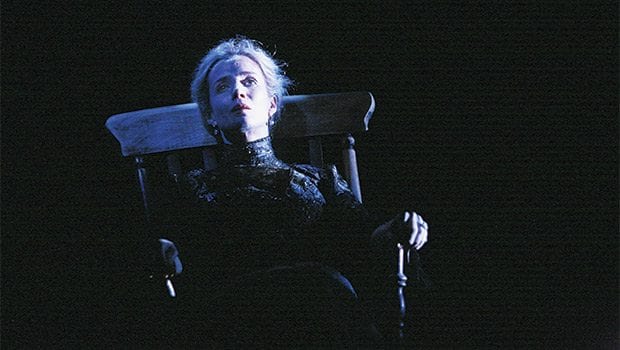
At the Emerson/Paramount Mainstage in Boston last week, ArtsEmerson presented “Not I/Footfalls/Rockaby,” a trilogy of three short plays by Samuel Beckett. This celebrated production envelops the audience into the same darkness that engulfs each play’s character, a lone woman performed by consummate actress and Beckett interpreter Lisa Dwan.
Samuel Beckett (1906-1989) is renowned for his 1953 tragicomedy “Waiting for Godot,” in which two tramps spar with each other as they pass their time awaiting deliverance of some sort. Its portrayal of human existence at its most basic is leavened by a bit of music hall humor.
Taking Beckett’s minimalism to a new level, this production by German director Walter Asmus, a long-time collaborator of Beckett, casts the theater in utter blackout.
Although three-minute pauses separate each short play, the production never ceases during its 60-minute duration. Its silent blackouts are part of the theater experience, bringing the audience into the same utter darkness that engulfs the figure on stage. Even the exit signs were turned off (the Boston Police installed infrared security cameras in case of emergency).
Several audience members took up the offer to be ushered out, following a procedure as prescribed as Beckett’s ritual-like stage directions: They were told to call out the word “usher” to summon a staff member who led them out. Scattered throughout the audience, their voices were like lone cries.
Aside from Kwan’s voice and the sound of her movements, the only other audible elements were recorded sounds of winds and chiming bells, and the low rumble of Green Line trains underfoot.
First presented in 2014 at the Royal Court Theatre, this staging is faithful to Beckett’s detailed directions. Its lighting, designed by James Jarncombe, is no less important than the words of the play, changing with the rhythms of each character’s voice and bodily movements. Beckett also specifies the costumes, an ethereal period dress for one role and for another, a black gown with sequins.
But the sole visible element in the first play, “Not I” (1972), is Dwan’s lipstick-red mouth and active tongue, which pierces this darkness like a tiny, flaming planet. Delivering a heroic performance throughout this short, wrenching work, Dwan voices a rapid succession of monosyllabic words and gibberish with the agility of a scat singer. Melodic at times, her voice also utters the shrieks, rasps, squeals and moments of raw laughter in the Beckett script, which evokes the murmurings of a demented person. At the end, her mouth disappears, fading out like a dying planet.
“I knew that woman in Ireland,” Beckett told biographer Dierdre Blair, “I knew who she was … there were so many of those old crones, stumbling down the lanes, in the ditches, besides the hedgerows.”
In “Footfalls” (1975), Dwan is a ghostly figure in a floor-length Victorian dress. She strides across the stage while carrying on a dialogue with the voice of an unseen, bed-ridden mother. With the rhythmic repetition of a metronome, she takes nine paces back and forth in a line of light, as she speaks, and, in one eerie moment, lip-syncs the mother’s words.
Dwan reappears seated in a rocking chair for “Rockaby” (1980). Unseen by others, she wears a black sequined gown and, gazing out of her window, she slowly rocks and chants phrases that conjure an aging woman’s reflections on a life of loneliness. Here and there, she punctuates her rhythmic, lullaby-like dirge with an abrupt shout, crying “More!” Her chanting and rocking gradually slow down until she becomes still and then slumps over.






